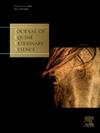Trends in reproductive technology use in the American Quarter Horse (AQHA)
IF 1.3
3区 农林科学
Q2 VETERINARY SCIENCES
引用次数: 0
Abstract
The acceptance of reproductive technology by a breed association is dependent on the cost of the procedure, interest in the technology by the breeder as well as the safety and efficacy of the procedure. The AQHA is the largest Breed Registry in the world with 3.1 million registered horses in 2023 and is an example of a registry that has embraced nearly all types of assisted reproduction techniques that have been developed. The AQHA registered 86,762 foals in 2023; 70,526 of these foals were born in the USA and 16,162 foals were born outside the USA. Approximately 8,500 AQHA registered foals were born in Europe, with the remaining international foals born primarily in Canada and Mexico. A significant number of Quarter Horse foals in Australia and South American countries were conceived by frozen semen exported from AQHA registered stallions standing in the US. These countries maintain their own Quarter Horse registries and therefore those foals are not reflected in the AQHA registry data. Data were obtained from the AQHA on the number of registered foals produced each year from embryo transfer (fresh and shipped embryos), frozen embryos, transported cooled and frozen semen. According to the AQHA data, the first foal registered by embryo transfer was in 1981. The number produced remained relatively low until the year 2000, when registrations increased dramatically to over 6000 in 2023. This was due in part to the development of commercial flushing and storage medias that allowed embryos to be collected on the farm and sent to large recipient stations for transfer. The first frozen/thawed embryo registered by AQHA was in 2012 and the numbers have only recently increased to 300-400 per year. Since in vivo derived embryos do not survive freezing and thawing very well (unless smaller than 300 microns), the vast majority of frozen embryos are derived by intracytoplasmic sperm injection (ICSI) and vitrified. Recently, ICSI has become accepted as a technique for in vitro embryo production and has been embraced by breeders, however AQHA does not currently collect data on the number of foals produced by ICSI. The first registered foal from cooled transported semen was in 1997 and the first from frozen semen occurred in 2000. The use of cooled transported semen increased dramatically to where about 14,000 foals are registered each year from the use of transported semen. It continues to be the procedure of choice, but the numbers of foals from frozen semen have increased over the past 15 years to where now 32% of foals from transported semen were sired by frozen semen. Through education and improvement in cryopreservation techniques and breeding strategies, frozen semen has been more widely accepted. AQHA has set restrictions on the use of certain technologies. For example, for stallions born after 2015 there is a limit on the use of frozen semen beyond 2 years following death.
美国四分之一马(AQHA)生殖技术使用趋势
品种协会对生殖技术的接受程度取决于手术的成本、育种者对技术的兴趣以及手术的安全性和有效性。AQHA是世界上最大的品种登记处,到2023年有310万匹马注册,是一个几乎涵盖所有已开发的辅助生殖技术的登记处的一个例子。2023年,AQHA登记了86,762头马驹;其中70,526头马驹出生在美国,16,162头马驹出生在美国以外。大约8500头在AQHA注册的马驹出生在欧洲,其余的国际马驹主要出生在加拿大和墨西哥。在澳大利亚和南美国家,有相当数量的四分之一马的小马驹是由AQHA在美国注册的种马出口的冷冻精液孕育的。这些国家维持着自己的夸特马登记,因此这些马驹没有反映在AQHA登记数据中。从AQHA获得了关于每年通过胚胎移植(新鲜和运输胚胎)、冷冻胚胎、运输冷却和冷冻精液产生的登记马驹数量的数据。根据AQHA的数据,第一只通过胚胎移植登记的小马驹是在1981年。生产的数量一直相对较低,直到2000年,当注册急剧增加到2023年超过6000。这在一定程度上是由于商业冲洗和储存介质的发展,使胚胎能够在农场收集并送到大型接收站进行转移。AQHA在2012年注册了第一个冷冻/解冻胚胎,直到最近才增加到每年300-400个。由于体内胚胎不能很好地冷冻和解冻(除非小于300微米),绝大多数冷冻胚胎是通过卵胞浆内单精子注射(ICSI)和玻璃化获得的。最近,ICSI已被接受为一种体外胚胎生产技术,并已被育种者所接受,然而AQHA目前没有收集ICSI生产的马驹数量的数据。1997年,第一个从冷却运输的精液中登记的小马驹出现,2000年,第一个从冷冻精液中登记的小马驹出现。冷却运输精液的使用急剧增加,每年约有14000匹马驹登记使用运输精液。它仍然是首选的程序,但在过去的15年里,从冷冻精液中出生的小马驹的数量有所增加,现在32%的小马驹是从冷冻精液中出生的。通过对冷冻保存技术和育种策略的教育和改进,冷冻精液得到了更广泛的接受。AQHA对某些技术的使用进行了限制。例如,对于2015年以后出生的种马,在死后2年以上使用冷冻精液是有限制的。
本文章由计算机程序翻译,如有差异,请以英文原文为准。
求助全文
约1分钟内获得全文
求助全文
来源期刊

Journal of Equine Veterinary Science
农林科学-兽医学
CiteScore
2.70
自引率
7.70%
发文量
249
审稿时长
77 days
期刊介绍:
Journal of Equine Veterinary Science (JEVS) is an international publication designed for the practicing equine veterinarian, equine researcher, and other equine health care specialist. Published monthly, each issue of JEVS includes original research, reviews, case reports, short communications, and clinical techniques from leaders in the equine veterinary field, covering such topics as laminitis, reproduction, infectious disease, parasitology, behavior, podology, internal medicine, surgery and nutrition.
 求助内容:
求助内容: 应助结果提醒方式:
应助结果提醒方式:


